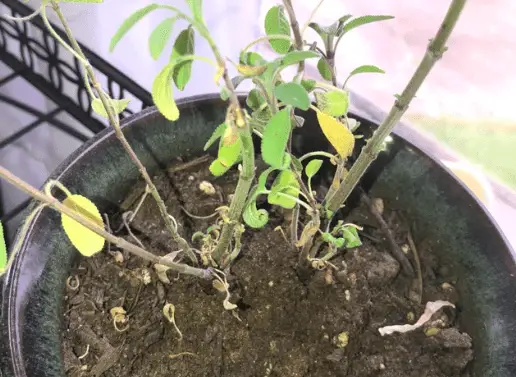Sage is a popular herb that can be used in both savory and sweet dishes. It’s a great addition to any garden, but it can be easy to overwater sage. If you’re not careful, you can kill this hardy plant with too much water. In this article, we will discuss how to save overwatered sage plants and help them get back on track!
How to Save Overwatered Sage?
1. Stop watering the sage plant
The first step is to immediately stop watering the sage plant. The goal here is to allow the plant to dry out completely. This may take a few days or a week, so be patient. Once the plant is dry, it will be able to start recovering from the overwatering.
If you’re not sure if your sage plant is dry enough, you can check the soil with your fingers. The soil should be crumbly and dry to the touch. If it’s still wet, wait a few more days before checking again.
Once the sage plant is dry, you can start watering it again. Be sure to water only when the soil is dry to the touch. This will help prevent overwatering in the future.
2. Re-pot the sage plant
If the sage has been severely overwatered, it’s a good idea to re-pot the plant. The goal here is to provide the plant with fresh soil that drains well. This will help the plant to recover more quickly.
Perlite is a great addition that can help with drainage. You can find perlite at most garden stores or online. Just be sure to add it to the new potting mix before planting the sage.
When re-potting, be careful not to damage the roots of the plant. Gently loosen the roots and then place them in the new potting mix. The pot should have drainage holes so that the water can easily escape.
3. Prune any rotting roots
Check the roots of the sage plant for any signs of rot. If you see any, you will need to prune them away. This may seem drastic, but it’s necessary in order to save the plant.
Start by removing any dead or dying leaves from the plant. Then, cut away any rotten roots with a sharp knife. Be sure to disinfect the knife after each cut to prevent the spread of disease.
4. Monitor soil moisture
It’s important to monitor the soil moisture levels when you’re growing sage. This will help you to avoid overwatering in the future. The best way to do this is to use a soil moisture meter.
You can find these at most garden stores or online. Stick the probe of the meter into the soil and wait a few seconds for a reading. The reading will tell you how much moisture is in the soil.
Remember that sage requires sandy or well-drained soil. This means that the soil should be dry to the touch before you water it again.
By following these steps, you can save your sage plant from overwatering. Just be sure to monitor the soil moisture and avoid watering too often in the future. Your sage plant will thank you for it!
How Much Water Do Sage Plants Need?
Sage grows best in full sun with well-drained soil. It’s a drought-tolerant plant, so it doesn’t need much water. In fact, too much water can kill sage. Water sage plants only when the soil is dry to the touch.
You can test the soil moisture by sticking your finger into the soil. If it feels moist, then the plant doesn’t need water. If the soil is dry, then it’s time to water the sage plant.
Water sage plants deeply so that the water reaches the roots. Water in the morning, so that the leaves have time to dry before nightfall. This will help prevent fungal diseases.
What Does Overwatered Sage Look Like?
Your sage will go droopy and its leaves will start to turn yellow if it’s overwatered. The plant may also develop root rot, which is when the roots start to break down and die.
You may see white powder on the leaves of your sage, which is a sign of mildew. This can happen if the air around your plant is too humid or if the leaves are exposed to too much moisture.

Conclusion
In conclusion, overwatering sage is a common problem. But by following the steps above, you can save your plant within a few weeks. The most important tips are to let the plant dry out completely, re-pot in fresh soil with good drainage, and monitor the soil moisture levels. By following these steps, you can have a healthy and happy sage plant!
Do you have any tips for saving an overwatered sage plant? Share them in the comments below!
Tim is an avid gardener from the UK. He was the founder of PlantCarer.com from 2021 to Sep 2023. He sold PlantCarer.com to Aaron. He has since started his own business called Seed To Supper, which provides new gardeners all the materials you need in a box (pots, seeds, compost and instructions) to grow your own delicious and nutritious vegetables and herbs from start to finish – no garden required.










0 Comments